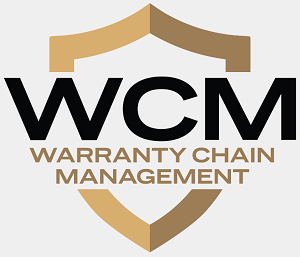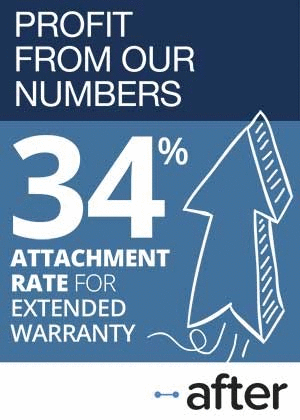March 12, 2008 |

|
ISSN 1550-9214 |
Ford's Warranty Costs:Figures presented at the Warranty Chain Management Conference last week showed a massive drop in the automaker's warranty expenses. But that had much to do with the accounting for the soon-to-be-sold Jaguar and Land Rover divisions. Still, even after adjusting year-ago figures to account for that impending sale, Ford's warranty costs are down significantly.
At the Warranty Chain Management Conference last week, following the keynote presentation by Donald Goodwin, vice president of global service at Chrysler LLC, Warranty Week editor Eric Arnum delivered an overview of some trends in the warranty industry. On February 27, only a week before the conference, the Ford Motor Co. had filed some surprising warranty figures as part of its Form 10-K annual report to the U.S. Securities and Exchange Commission. In fact, the data was so surprising it could hardly be believed. But the math was correct: $3.3 billion in claims on $154.4 billion in sales translated into a 2.1% claims rate, down a full 7/10ths of a percent from 2006. Sure, the company was cutting costs, but not by that much. The notch in the chart looked like a front tooth had been knocked out of the data. Something was wrong. And nobody -- not one of the thousands of financial analysts who ponder every sentence uttered in Detroit -- had noticed. The problem was that late last year, Ford had packaged Jaguar and Land Rover for sale, but the sale hadn't actually yet taken place. So the company's warranty expenses had apparently fallen without any corresponding fall in revenue. And the two nameplates that were moved into the holding pattern were responsible for a disproportionately large share of Ford's warranty expenses. Here's what happened: In Ford's annual report, the company reclassified Jaguar and Land Rover as "Held-for-Sale Operations," which means they weren't yet completely discontinued operations, but they were headed in that direction. Comparing Apples to OrangesIn Note 20 to the annual report, Ford separately listed assets and liabilities for those operations as of Dec. 31, 2007, which means that at least the warranty reserve had already been effectively split. However, the revenue has not yet been split. In other words, the $154.4 billion in automotive revenue listed for 2007 still included Jaguar and Land Rover, along with revenue from the Volvo, Ford, Lincoln, and Mercury nameplates. So when we divided one figure by the other to calculate a 2.1% claims rate, it was like comparing apples to oranges. Elsewhere in the report, Ford listed a year-ending balance of $4.862 billion in its own warranty reserve fund, and counted $3.287 billion in net claims paid during 2007, along with $2.894 billion in warranty accruals. But that can't be compared against a revenue figure that still includes Jaguar and Land Rover. So let's fix that calculation. Let's take that company-wide revenue number and separate Jaguar and Land Rover from the rest of Ford. However, keep in mind that as soon as we do so, we've left the world of exact math and have entered the world of estimates. So consider everything that follows in this column as speculative until Ford actually makes the sale and officially reclassifies the Jaguar and Land Rover units as "Discontinued Operations" (as it has already done with Aston Martin). The Premier Automotive Group once included Aston Martin, along with Volvo, Land Rover, and Jaguar. However, each separate nameplate is not broken out separately. So to make the split, we have to make some assumptions about sales of each of the nameplates within the PAG sector. In 2007, according to Ford's annual report, PAG nameplates sold 774,000 units and generated $33.1 billion in revenue. Both figures were up from 2006, when PAG sold 730,000 units and generated $30 billion in revenue. These figures do not include Aston Martin, but they do include Volvo. And Volvo is not being sold to Tata Motors. So after the sale takes place, PAG will disappear and will be replaced by a line just for Volvo. Splitting RevenuesThe first step is to split those unit and revenue totals between Volvo and Jaguar/Land Rover. But Ford has not yet made that split. Fortunately, however, there are clues to be found elsewhere. We came across a Feb. 20 press release in which Volvo announced worldwide 2007 sales of 458,323 cars. If one assumes an average selling price of US$39,500 per vehicle -- which is reasonable given the current strength of the pound and euro against the dollar -- one could estimate that Volvo's worldwide revenue was in the neighborhood of $18.1 billion in 2007. That would imply that 59% of PAG's vehicles were Volvos, and 55% of PAG's revenue was from the Volvo nameplate. And that in turn means that 41% of PAG's vehicles were either Jaguars or Land Rovers, along with 45% of PAG's revenue. Again, we are rounding everything off heavily, because that's all one can expect when dealing with estimates. But that leaves us with an estimate of $15 billion for 2007 Jaguar and Land Rover revenue. And that's the key figure that we need to proceed with our model. Let's assume for this exercise that Jaguar and Land Rover generated exactly $15 billion in 2007 revenue, and the rest of Ford (including Volvo) generated $139.4 billion in automotive revenue. So the split is roughly 9.3 to 1 between Ford and its held-for-sale operations. Working back in time, let's also assume that the Jaguar and Land Rover revenue total in 2006 was $14.1 billion, and the rest-of-Ford number was $129.2 billion. That would translate into 6.4% year-over-year revenue growth for Jaguar and Land Rover, and 7.9% growth for rest-of-Ford. In a supposedly slow year, both figures are surprisingly good. Now, let's dive into the warranty figures. Here's what Ford included in its annual report for its warranty costs:
As far as we know, those figures are for Ford worldwide minus Jaguar and Land Rover. And now that we have a revenue estimate for Ford minus Jaguar and Land Rover, we can now calculate rest-of-Ford figures for the claims and accrual rates. For claims, $3.287 billion divided by $139.4 billion equals a 2.4% rate. For accruals, $2.894 billion divided by $139.4 billion equals 2.1%. In other words, Ford really has cut its warranty costs, and not just by accounting alchemy. But to figure out by how much, we need to also restate the corresponding 2006 figures. And we also need to figure out what has happened to Jaguar and Land Rover in 2006 and 2007. Fortunately, Ford included enough crucial clues in its annual report to make that possible. In Note 20, the beginning and ending balances for the warranty reserve fund of Jaguar and Land Rover were reported as $759 million and $645 million, respectively. But there were no figures included for either claims paid or accruals made over the course of the year. Therefore, even though we know there was a net drop of $114 million in the balance, and therefore that claims outpaced accruals during 2007, we don't have exact figures for either metric. We don't even have estimates. More AssumptionsHere's where this model ventures deep into experimental territory. Let's assume that because Ford's claims and accrual rates have changed only gradually over the past five years, they also changed only gradually over the course of 2007. Therefore, if we look back to the first quarter of 2007, before Jaguar and Land Rover were packaged for sale, we might find a figure that would have been valid for the whole year, if Jaguar and Land Rover had never been packaged for sale. During the first quarter of 2007, Ford's claims rate was 2.6% and its accrual rate was 2.3%. Let's assume those percentages would have held for the entire year, had PAG remained intact. So what dollar-amount figures, we wonder, would have resulted in the same full-year claims and accrual rates, based on $154.4 billion in full-year automotive sales revenue? The rounded-off answers are $4 billion in claims and $3.5 billion in accruals. In other words, to calculate figures for Jaguar and Land Rover, we take the known rest-of-Ford numbers from above, and subtract them from the would-have-been figures we just calculated. That suggests Jaguar and Land Rover had claims of $713 million and that Jaguar and Land Rover had accruals of $599 million in 2007. We don't really know if there were any currency adjustments or changes of estimate, and we don't want to make too many assumptions. So let's just assume that they cancelled each other out. If, for instance, there was a downwards change of estimate of $50 million, let's assume there was an upward currency adjustment of $50 million. That assumption would therefore have no effect on the ending balance. Therefore, we can construct the following warranty table for Jaguar and Land Rover in 2007:
Now we can make some calculations regarding Jaguar's and Land Rover's combined warranty claims and accrual rates. For claims, $713 million divided by $15 billion equals 4.8%. For accruals, $599 million divided by $15 billion equals 4.0%. Given the reported warranty problems those nameplates had in 2006, those estimates seem reasonable. In fact, it's about where DaimlerChrysler was when it had a bout of warranty influenza in 2005. As we prepare to release aggregate warranty numbers for all American manufacturers in 2007, however, one metric we will need to know is how last year's figures compare to 2006 for each of the top 100 warranty providers. Obviously, Ford will make that list. And with Ford, so far we've constructed an apples-to-apples comparison for 2007, but the 2006 figures are still apples-to-oranges. So while we know there's been improvement, we don't know how much. Using the same methodologies outlined above, we separated Ford in 2006 into a Jaguar and Land Rover bucket and a rest-of-Ford bucket. Being as we assumed Jaguar and Land Rover had $14.1 billion in 2006 revenue (based on 300,000 vehicles sold at an average price of $46,500), that leaves the rest of Ford at $129.2 billion. In its 2007 annual report, Ford provided the following helpful data for its year-ago warranty reserve fund. And since this year-ago accounting does not include Jaguar or Land Rover, part of our job has been done for us, and the figures below can be used to calculate rest-of-Ford claims and accrual rates for 2006:
Those figures combined with our rest-of-Ford revenue estimate result in a 2006 claims rate calculation of 2.7% and a 2006 claims rate of 2.3%. That's significantly above the 2.4% and 2.1% rates we just calculated for claims and accruals 2007. In other words, even after separating out Jaguar and Land Rover, Ford has cut its rest-of-company warranty costs somewhat dramatically. Still, we don't know how Jaguar and Land Rover did last year in comparison to 2006. Ford has noted "the non-recurrence of adverse 2006 adjustments to Jaguar and Land Rover warranty accruals," but what happened in 2006? Again, the company has left us some clues to figure it out. To solve for Jaguar and Land Rover in 2006, all one needs to do is subtract what Ford reported in its 2007 annual report as year-ago figures from what Ford reported in its 2006 annual report for the then-current year. The difference between those two sets of figures are as follows:
That $499 million figure we're listing under other changes in the table above must be the "adverse 2006 adjustment" that Ford was forced to make when warranty claims spiked at Land Rover. However, some of that money apparently wasn't spent until 2007. And indeed, we're estimating that Ford took back $50 million in 2007 as a downwards change of estimate. So perhaps the adversity wasn't as severe as it expected? With that $14.1 billion revenue figure in hand, we're estimating that Jaguar and Land Rover together had a 4.2% claims rate in 2006. How much was Jaguar and how much was Land Rover? We'll probably never know. As for the accrual rate, it all depends on whether you include or exclude the $499 million adjustment. Without it, the nameplates had a 3.3% accrual rate. But with it, they had a 6.8% accrual rate. No wonder Ford decided to package them for sale! The only problem with these new warranty tables is a $38 million discrepancy between the closing balance of 2006 and the opening balance of 2007. But it turns out that this is the Dec. 31, 2006 warranty reserve balance that Aston Martin apparently took with it when it was officially sold. We could work backwards to make separate estimates for that nameplate too, but we've probably already reached a point where too much alchemy has already been performed on this financial model. Suffice it to say that Jaguar and Land Rover outpaced Aston Martin more than twenty-fold, in terms of both warranty costs and units sold. So there wouldn't be much change in the outcome, with or without them. However, look at the numbers we're suggesting for Ford in 2006 and 2007. Even after fixing the numbers to account for the sale of Jaguar and Land Rover, we're estimating a sizeable drop in both the claims and accrual rates. We're estimating a 2006-to-2007 drop in the claims rate from 2.7% to 2.4% -- a 13% decline. And we're estimating a 2006-to-2007 drop in the accrual rate from 2.3% to 2.1% -- a 10% decline. For a company of this size, those are big numbers. We'll see in a few weeks time when the top 100 warranty providers are listed. Dropping Off the Charts?As for Jaguar and Land Rover, it's highly likely that they are going to fall out of our warranty charts in 2008. Just as Lucent Technologies went beyond the reach of the SEC when it merged with the French company Alcatel, and just as Chrysler stopped reporting to the SEC when it was taken private, so too will Jaguar and Land Rover cease to be included in the statistics for publicly-traded and American-based manufacturers once they are acquired by Tata Motors. Then again, they were always solidly British automakers, even while owned by Ford. For the most part, foreign companies are not required to include any warranty figures in their annual reports, and most choose not to. Therefore, we have no facts at all regarding how major automakers such as Volkswagen, Nissan, Renault, BMW, and Hyundai are doing in terms of their warranty costs. And now, after Chrysler went private, Mercedes also ceased providing any guidance on its warranty costs last year. So one could say that warranty cost secrecy is the norm in Europe. However, Tata Motors usually includes warranty figures in its annual reports. And they're generally very small figures, given the company's size. So we're going to have to start doing some studies of generally accepted accounting principles in India, to see how it's possible that a major automaker (and truck maker) can so consistently keep its claims rate below 1%. We can only hope that along with Fiat, Toyota, and Honda, Tata continues to report at least its annual warranty data. In the year ended March 31, 2006, Tata Motors reported 1.76 billion rupees in claims on 236.9 billion rupees in net sales, for a claims rate of only 0.7% (43 rupees = US$1.00). In the year ended March 31, 2007, the company reported 2.06 billion rupees in claims on 324.5 billion rupees in net sales, for an even lower claims rate of 0.6%. That means the warranty departments of Tata's new acquisitions will outspend it by a margin of 15 to 1. Will that make Tata as shy about its warranty costs as some of its new European competitors? We hope not. But one thing we can say for certain: After it absorbs Jaguar and Land Rover, its sub-one-percent days will be over. | ||||||||||||||||||||||||||||||||||||||||||||||||||||||||||||||||||||||||||||||||||||||||||||
| ||||||||||||||||||||||||||||||||||||||||||||||||||||||||||||||||||||||||||||||||||||||||||||








